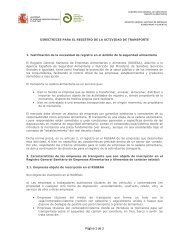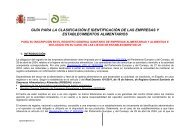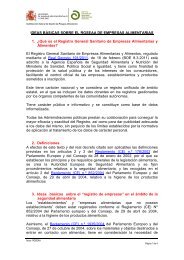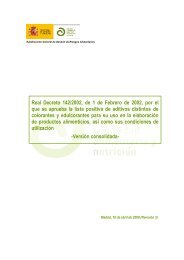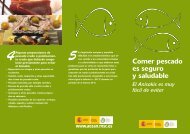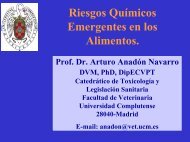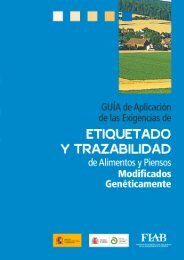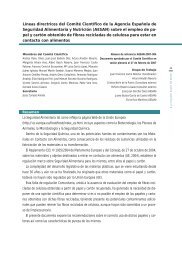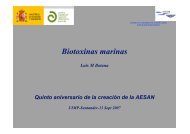Descargar - Agencia Española de Seguridad Alimentaria y Nutrición
Descargar - Agencia Española de Seguridad Alimentaria y Nutrición
Descargar - Agencia Española de Seguridad Alimentaria y Nutrición
Create successful ePaper yourself
Turn your PDF publications into a flip-book with our unique Google optimized e-Paper software.
74<br />
revista <strong>de</strong>l comité científico nº 10<br />
soja, aconsejan un control específico <strong>de</strong> la cantidad <strong>de</strong>l elemento y obtener información a<strong>de</strong>cuada<br />
para evaluar los posibles riesgos <strong>de</strong>rivados.<br />
En población adulta los aditivos alimentarios que contienen Al pue<strong>de</strong>n contribuir <strong>de</strong> forma significativa<br />
a la ingesta dietética por lo que es necesario realizar estudios <strong>de</strong> toxicidad a<strong>de</strong>cuados, especialmente<br />
para valorar sus efectos.<br />
El potencial neurotóxico <strong>de</strong>l Al hace necesario disponer <strong>de</strong> estimaciones <strong>de</strong> la exposición dietética<br />
al mismo en nuestro país, recomendando este Comité que se <strong>de</strong>ben incluir métodos que permitan<br />
i<strong>de</strong>ntificar sus fuentes, intrínseco o adicionado (aditivos, consecuencia <strong>de</strong>l procesado, migraciones a<br />
partir <strong>de</strong> envases <strong>de</strong> almacenamiento, etc.).<br />
Palabras clave<br />
Aluminio, ingesta dietética, seguridad, toxicidad.<br />
Report of the Scientific Committee of the Spanish Agency for Food Safety<br />
and Nutrition (AESAN) in relation to the possible risk of dietary aluminium.<br />
Abstract<br />
In 2006, the FAO/WHO Joint Expert Committee on Food Additives (JECFA) took into account the<br />
effects induced by some aluminium compounds on reproduction and the <strong>de</strong>velopment of the nervous<br />
system, and so reduced the Provisional Tolerable Weekly Intake (PTWI) of Al from 7 mg Al/kg bw/week<br />
to 1 mg Al/kg bw/week. This reduction was subsequently accepted by the European Food Safety<br />
Authority (EFSA, 2008a, 2008b), which issued a scientific opinion on the safety of consuming aluminium<br />
in the diet, in which it was estimated that a major part of the population of Europe could be<br />
exceeding the safe threshold established.<br />
Dietary exposure in adults not exposed to Al through their occupations reveals great variability<br />
from one country to another, and even within the same country. Thus, EFSA has reported that adults’<br />
exposure through consumption of food and water ranges between 0.2-1.5 mg Al/kg bw/week for a<br />
mean weight of 60 kg and it is estimated that, among children and teenagers, dietary exposure at<br />
the 97.5 percentile is 0.7-2.3 mg Al/kg bw/week in some countries (United Kingdom and France). The<br />
available studies do not allow the i<strong>de</strong>ntification of the specific dietary sources of Al, nor any differentiation<br />
between the multiple origins of Al including intrinsic Al, aluminium from food additives and<br />
the Al resulting from food preparation and storage processes.<br />
The aluminium content in foodstuffs analyzed in different European countries displays relatively<br />
elevated variability, even among the members of a single group.<br />
The AESAN Scientific Committee consi<strong>de</strong>rs the new intake safety threshold set by EFSA to be a<strong>de</strong>quate<br />
at 1 mg Al/kg bw/week.<br />
The Committee has highlighted the scarcity of data about Al content in food in our country. The high<br />
Al contents found in some milk formula for infants, particularly soy-based products, make it advisable<br />
to carry out a specific check of the amount of this element so as to obtain suitable information to<br />
assess the potential risks <strong>de</strong>riving from this.





